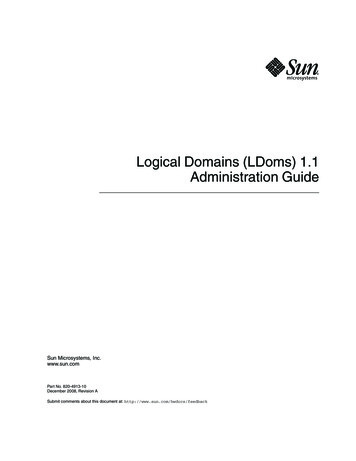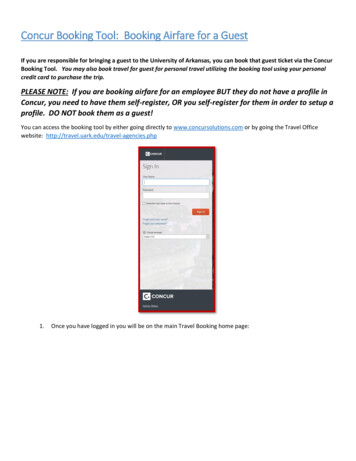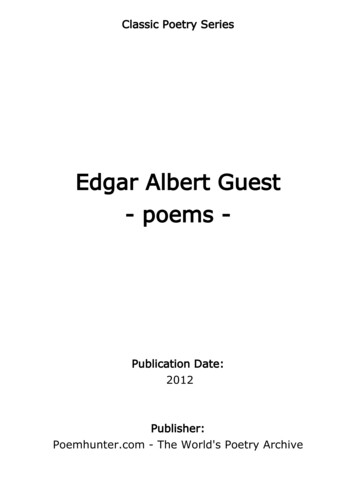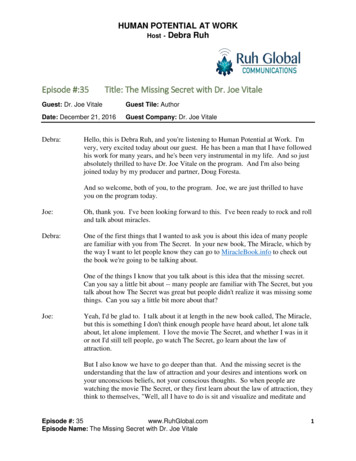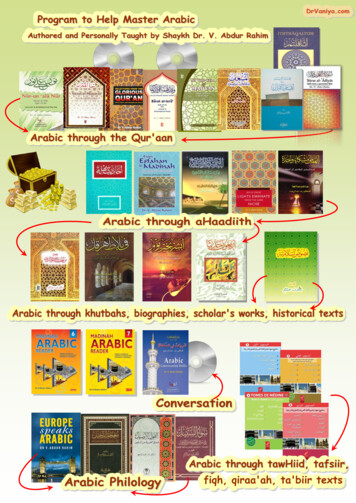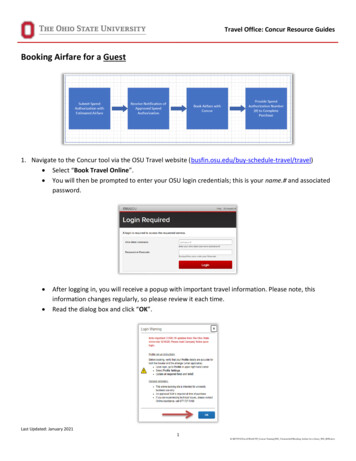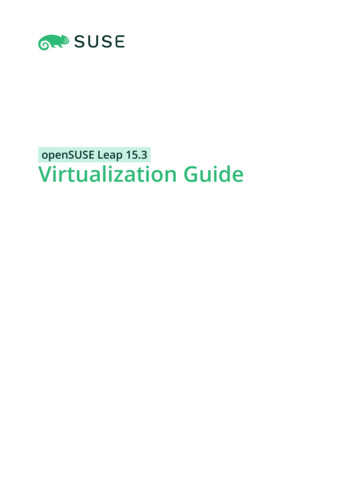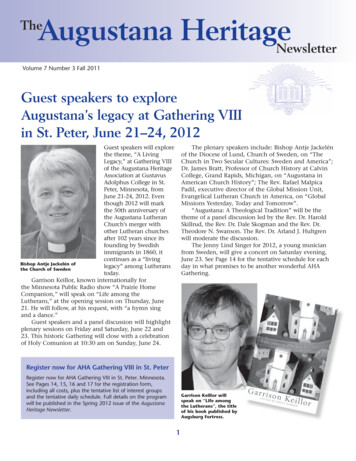
Transcription
Augustana HeritageNewsletterTheVolume 7 Number 3 Fall 2011Guest speakers to exploreAugustana’s legacy at Gathering VIIIin St. Peter, June 21–24, 2012The plenary speakers include: Bishop Antje Jackelénof the Diocese of Lund, Church of Sweden, on “TheChurch in Two Secular Cultures: Sweden and America”;Dr. James Bratt, Professor of Church History at CalvinCollege, Grand Rapids, Michigan, on “Augustana inAmerican Church History”; The Rev. Rafael MalpicaPadil, executive director of the Global Mission Unit,Evangelical Lutheran Church in America, on “GlobalMissions Yesterday, Today and Tomorrow”.“Augustana: A Theological Tradition” will be thetheme of a panel discussion led by the Rev. Dr. HaroldSkillrud, the Rev. Dr. Dale Skogman and the Rev. Dr.Theodore N. Swanson. The Rev. Dr. Arland J. Hultgrenwill moderate the discussion.The Jenny Lind Singer for 2012, a young musicianfrom Sweden, will give a concert on Saturday evening,June 23. See Page 14 for the tentative schedule for eachday in what promises to be another wonderful AHAGathering.Guest speakers will explorethe theme, “A LivingLegacy,” at Gathering VIIIof the Augustana HeritageAssociation at GustavusAdolphus College in St.Peter, Minnesota, fromJune 21-24, 2012. Eventhough 2012 will markthe 50th anniversary ofthe Augustana LutheranChurch’s merger withother Lutheran churchesafter 102 years since itsfounding by Swedishimmigrants in 1860, itcontinues as a “livingBishop Antje Jackelén oflegacy” among Lutheransthe Church of Swedentoday.Garrison Keillor, known internationally forthe Minnesota Public Radio show “A Prairie HomeCompanion,” will speak on “Life among theLutherans,” at the opening session on Thursday, June21. He will follow, at his request, with “a hymn singand a dance.”Guest speakers and a panel discussion will highlightplenary sessions on Friday and Saturday, June 22 and23. This historic Gathering will close with a celebrationof Holy Comunion at 10:30 am on Sunday, June 24.Register now for AHA Gathering VIII in St. PeterRegister now for AHA Gathering VIII in St. Peter. Minnesota.See Pages 14, 15, 16 and 17 for the registration form,including all costs, plus the tentative list of interest groupsand the tentative daily schedule. Full details on the programwill be published in the Spring 2012 issue of the AugustanaHeritage Newsletter.Garrison Keillor willspeak on “Life amongthe Lutherans”, the titleof his book published byAugsburg Fortress.1
Volume 7, Number 3Fall 2011Published by:Augustana Heritage Association1100 E. 55th StreetChicago, IL 60615-5199Website: www.augustanaheritage.orgEditor: Ronald T. EnglundDesigner: Ann ReznyWith comments, story ideas and manuscripts, please contact:Ronald T. Englund44 Lakeview AvenueFalmouth, MA 02540(508) 495-1621englund@cape.comFor information about the Augustana Heritage Association,please contact:Ruth Ann DeppeAHA office1100 E. 55th StreetChicago, IL 60615-5199(800) 635-1116, ext. 757 – switchboard(773) 256-0757 – directrdeppe@lstc.eduAHA Board of DirectorsPresidentDonald J. Sjoberg, Edmonton, Alberta, CanadaThe Augustana Heritage Association defines,promotes, and perpetuates the heritage and legacyof the Augustana Evangelical Lutheran Church.contentsFrontCoverGuest speakers at Gathering VIII3Gustavus begins SesquicentennialWhither AHA?5Paul Granlund, sculptor at Gustavus for 25 years7 Global Tensions, Augustana and World Lutheranism11 Book Review: “A Journey of Grace” by Herb Chilstrom13 Report of AHA Board of Directors meeting AHA Book Fund: an aggressive publishing program14Gathering VIII 2012 – Schedule15Gathering VIII 2012 – Registration Form17Gathering VIII 2012 – Interest GroupsReport of AHA treasurer18The Augustana Liturgy by Ronald Bagnall21Lutherfest at Midland University and Wahoo22An untimely death in the Augustana SynodTreasurerP. Gerald Leaf, Lindsborg, Kansas24Book Review” “Light and Leaven” by Ann BoadenExecutive DirectorDavid E. Baker, Penn Valley, California25Augustana Institute at LTSPVice-PresidentHarold T. Nilsson, Albuquerque, New MexicoSecretaryAnn Kohler, Baldwinsville, New YorkAHA Office ManagerRuth Ann Deppe, Chicago, Illinois26AHA Newsletter EditorRonald T. Englund, Falmouth, Massachusetts and London, EnglandBoard MembersJ. Roger Anderson, Sun City West, ArizonaLoran Bohman, Youngwood, PennsylvaniaHerbert W. Chilstrom, St, Peter, Minnesota and Green Valley, ArizonaTerry O. Denley, St. Peter, MinnesotaMarilyn E. Jackson, Richmond, CaliforniaTheodore C. Johns, Sunrise Beach, TexasHelene Leaf, Moline, IllinoisJohn E. Norton, Moline, IllinoisCurtis L. Olson, Easton, PennsylvaniaDorothy Palmquist, Minneapolis, MinnesotaDale Skogman, Gladstone, Michigan27BackCoverAdvisors to the BoardPaul M. Cornell, Lansdale, PennsylvaniaArland J. Hultgren, Lino Lakes, MinnesotaKathryn Segerhammer Swanson, Fort Collins, Colorado2Wives of Augustana pastors from JamestownWord from the EditorNews and EventsBooks, CDs and DVDs for sale by AHA
Gustavus begins sesquicentennial celebrationphoto courtesy of Gustavus Adolphus CollegeEric Norelius and other Swedish immigrant leaders inMinnesota saw a need to educate their children, so thatthey might succeed in their new communities and teachChristian principles. They looked to build a school inMinnesota and, in 1861, founded Gustavus AdolphusCollege in St. Peter, naming the school after the 17thcentury Swedish king.Over the last 150 years, much has changed, yet inthis time Gustavus Adolphus College has stayed true toits mission, educating nearly 42,000 students to lead andserve their communities.Gustavus kicked off the celebration of its 150th academic year in the fall of 2011, and will conclude the festivities at Homecoming, October 13-14, 2012. The yearwill be filled with reflections on the past, celebrations ofthe present, and opportunities for future engagement.Gustavus Adolphus College: Statue of 17th centurySwedish King Gustavus Adolphus and chapel tower Celebration of Martin Luther King Jr. with presentation byDr. King biographer, Taylor Branch Moe Lecture featuring Dr. Jackson Katz, leading anti-sexistmale activist, filmmaker, author, and lecturer Gustavus Music Showcase concert in the Twin Cities featuring commissioned works for choir, wind orchestra, and symphony orchestra from Eric Whitacre, James Stephenson, andChen Yi Pulitzer Prize winning American Civil War historian andGustavus graduate James McPherson as visiting scholar Lindau Symposium featuring Charles Krauthammer, physician, Pulitzer Prize winning syndicated columnist, and political commentator Celebrating of 150 years of faith and 50 years of ChristChapel: Featuring ELCA Bishop Mark Hanson as keynotespeaker in conjunction with the gathering of the Associationof Congregations The MAYDAY! Peace Conference focusing on immigration Out of Scandinavia featuring playwright Jonas Hassen Khemiri Gustavus Sesquicentennial inspired dance by site-specificchoreographer Stephan KoplowitzSesquicentennial celebration plans include: Publishing a new pictorial history book and a new scholarlyhistory book Hosting an exhibit of Scandinavian art–contributions fromthe National Museum, Modern Museum, and Thiel Gallery Dedication of a new academic building and west mall oncampus Dedication of Gustavus space in the new American SwedishInstitute addition 34 Sesquicentennial Celebrations around the country Athletic Sesquicentennial Events for all 26 sports Gustavus Music Colloquium Series featuring eight concertswith discussion A year of Global Insight focused on the Circumpolar regionof the world 47th annual Nobel Conference: The Brain and Being Human Raoul Wallenberg Memorial Lecture: Bonhoeffer andRepentance: A Constructive Proposal for Christian Public Witness Christmas in Christ Chapel: Julljus: Light from the Old World;Light to the New Commemorating Controversy: The US-Dakota War of 1862Speaker SeriesFor more detailed information on the Sesquicentennial,go to www.gustavus.edu/150Whither AHA? Thoughts from the Future Committeeby Hal Nilsson, Future Committee ChairNext year, a half-century will have passed since theAugustana Lutheran Church gave up its life to becomepart of a larger Lutheran body in North America.Augustana thus is a living memory for an aging andsteadily declining number of us. For more than a decade,the Augustana Heritage Association (AHA) has perpetuat-ed the legacy of this church of Swedish immigrant originthrough well-attended gatherings, a popular newsletter,and scholarly publications. The questions are, how muchlonger can AHA continue, in what form, and what giftsfrom Augustana should be preserved when present particicontinued on Page 43
Whither AHA?continued from Page 3pants no longer are on the scene?Last spring and summer, AHA’s Future Committeesought input on these questions through a survey postedon the organization’s website, www.augustanaheritage.org. By mid-July 2011, more than a hundred responded.(Thanks to all of you who took time to answer thequestions!) Valued most in respondents’ memory ofAugustana is “its sense of church beyond the congregation,” followed closely by “its care for liturgical worship,” “its concern for social justice,” and “its emphasison global mission.” These are values that should bepassed on to the ELCA and ecumenically, say the surveyparticipants. How we do this is a work in progress.But first, it is clear that as long as there are peoplewho experienced Augustana first-hand, they want togather. The Future Committee and the board havereceived that feedback from the survey and othersources. For many of us, life-long friendships beganin Luther League, Bible camp, and at the church’s colleges and seminary. The 2012 Gathering at GustavusAdolphus College is the next major opportunity torenew those friendships. This Gathering VIII likely willbe the last of the full four-day events that have beenheld every two years since 1998. However, calls for anevent that would highlight the history of Luther JuniorCollege, Wahoo, Nebraska, the Augustana school thatmerged with Midland University in 1962, have resultedin tentative plans to hold a scaled-down AHA event onMidland’s campus in Fremont, Nebraska, in 2014. If thisevent takes place, two other Augustana institutions withroots in Nebraska, Bethphage Mission and ImmanuelDeaconess Institute certainly will be celebrated.AHS on a newsletter, other publications and public eventsappears quite feasible. Also, AHA’s membership records andfiles may be located in the Historical Society’s office.Augustana’s values will be preserved by the financial gifts we leave behind. At next year’s Gathering, AHAmembers will receive an updated version of Continuing theLegacy of Augustana: A Program of the Augustana HeritageAssociation, a brochure outlining numerous opportunitiesto make gifts and bequests to institutions and agenciesfounded by the Augustana Synod or that carry forwardour heritage. Among these are the Jenny Lind ChapelEndowment Campaign to raise funds for the preservation of the original Augustana church, and the AugustanaInstitute (earlier named “Augustana Room”) at LutheranTheological Seminary at Philadelphia.Reaching the younger generationThe website survey question that drew the longestresponses asked for ideas to reach new, younger members, those who were children or not even born whenAugustana merged into the LCA. Many respondentscherish the values and friendships received throughAugustana, but are clear-eyed about the difficulty of conveying one generation’s experiences to the next. Theyare not sanguine about AHA continuing much longer.Others believe there still is energy and enthusiasm to support AHA’s purpose. Some challenge AHA to find youngerpersons for leadership positions. At least one respondentmakes a point of bringing “younger” persons to AHAGatherings, that is, those who are 50 to 60 years of age.They come away inspired, said the writer. Last spring theAHA Board itself was challenged by a presentation froma “younger” daughter of Augustana who is a former staffperson in the ELCA’s Global Mission division. She thinks,for example, the ELCA can benefit by assimilating more ofAugustana’s commitment to global mission.During the fall and winter, the Future Committee andAHA Board will wrestle with the organization’s future.They will try to discern whether the purpose and functions articulated a decade ago still are relevant or needto be revised. They will attempt to outline AHA’s work atleast through 2014, and formulate recommendations forthe membership to consider in St. Peter in June 2012. Andthey will not give up efforts to find “younger” leaders.Your comments and prayers are invited as we carry on.Events with Augustana rootsWhen and where else might Augustana friends reunite?Many events around the country attract those withAugustana roots, among them the Messiah Festival atBethany College, Lindsborg, Kansas; the annual serviceusing the Augustana liturgy held at Normandale LutheranChurch, Edina, Minnesota; Swedish services at the JennyLind Chapel, Andover, Illinois; and the ScandinavianFestival at California Lutheran University in ThousandOaks. Using the newsletter and website, AHA can publicize and encourage attendance at such events.AHA has contributed to the Augustana legacy by sponsoring several books and participating in scholarly conferences. The Future Committee imagines that contributioncan continue, probably in revised form, by joining forceswith the Augustana Historical Society based at AugustanaCollege in Rock Island. The Society’s purpose includesassembling materials that relate to churches founded bySwedish immigrants. Collaboration between AHA andThe Rev. Dr. Harold T. (Hal) Nilsson, a 1965 graduate of theLutheran School of Theology/Rock Island, served congregations in California, Utah, and New Mexico, before retiring.He grew up at First Lutheran Church, Palo Alto, California,a congregation founded by Augustana in 1920. You are welcome to send him your comments at revhtn@gmail.com.4
Paul Granlund, sculptor at Gustavus for 25 years,was a premier artist throughout the worldPaul Granlund was sculptor-in-residence at GustavusAdolphus College from 1971 until his retirement in1996. In a creative career spanning more than 50 yearsand more than 650 works, he had been recognized asa premier sculptor throughout the United States andabroad. His figurative bronze sculptures have beeninstalled in public and private settings from Australia toItaly to India, from Minneapolis to Hong Kong.Granlund was born in Minneapolis on October6, 1925, the son of Augustana pastor, Clarence O.Granlund, and NaomiMoren Granlund. A 1952graduate of Gustavus,he went on to receive aMaster of Fine Arts degreefrom the CranbrookAcademy of Art inMichigan in 1954. In thatsame year, he was oneof the three Americansawarded Fulbright fellowships to study sculpturein Italy. A fellowshipin creative sculpturefrom the GuggenheimFoundation allowed himto return to Italy, wherehe stayed from 1957 to1959. During the 1960s,Paul Granlundhe was on the faculty ofthe Minneapolis Collegeof Art and Design.Granlund won several major competitions for hiswork, including the Minnesota Governor’s competition for a Vietnam War memorial, the Dubuque (Iowa)Five Flags Plaza Bicentennial sculpture competition,and the “International Year of the Adolescent” sculpture competition sponsored by the Wilson Center ofFaribault, Minnesota. His work has been exhibited atmore than 70 one-man shows in galleries and museums in Minneapolis, New York, Chicago, St. Louis, SanFrancisco, Los Angeles, and several other cities. In 1987,his sculpture of Charles A. Lindbergh was installed at LeBourget Field in Paris. Constellation Earth, an eight-footsphere celebrating the global family, was placed in PeacePark in Nagasaki, Japan, in 1992.Closer to home, castings of his sculptures have beeninstalled at the Minnesota State Capitol, the WorldTrade Center in St. Paul, the Mayo Clinic in Rochester,as well as in a number of churches, hospitals, and colleges in the region.Beyond his art, he was beloved for his inquisitive mind and his hospitality in welcoming anyoneto his studio while he worked. Current GustavusSesquicentennial Sculptor and apprentice to Granlund,Greg Mueller, says, “The Granlund Sculptures on thisphoto courtesy of Gustavus Adolphus Collegephoto courtesy of Gustavus Adolphus Collegeby Barb Larson TaylorJacob and the Angel (1962)In this first Granlund sculpture to have been placedon the Gustavus campus, Jacob and the Angel, is nowplaced at the west entrance of the Ogden P. ConferHall and Edwin J. Vickner Language Hall. The sculptureshows an ambiguous figure dissolving into formlessclay or sprouting wings? Is it about to fall or to springupright? In the Genesis story, Jacob wrestles with eithera man or an angel. Granlund’s single figure helps us tosee that Jacob’s contest for identity, mastery, and courage, which is our own, is an inner struggle.campus are not necessarily a visual luxury, rather, a celebration of the College’s core values given physical form.Granlund’s open door to students and visitors providedan intangible asset to the community, weaving its wayinto the liberal arts mission as a working place of creative research and alternative classroom of teaching andlearning. As a former studio assistant, I certainly feel it5
photo courtesy of Gustavus Adolphus Collegephoto courtesy of Gustavus Adolphus CollegeLuna Moth Matrix (1980)This is one of three Granlund sculptures to grace the Christ Chapel grounds. To theeast of the chapel, Luna Moth Matrix, a metaphor of the promise of resurrection andrenewal, celebrates the memory of Douglas Sandberg. Time and space are combinedas the sculptor converts into mass the fluttering of moth wings which normallyhappens in time. Movement is suggested in the posture and balance of one wingsuspended in space on its tip. Embedded in that wing is a fetal male figure indicative of the chrysalis state; on the opposite side, the wings carry the impression of anextended female figure implying liberation and flight.Linnaeus (1988)The stylized Linnaeus (Head of Carl von Linné) wasplaced at the entrance to the Linnaeus ArboretumInterpretive Center in the spring of 1988 to commemorate the Swedish natural scientist who livedfrom 1707 to 1778. Paul Granlund writes, “Sincethe Linnaeus name was derived from the image of alime tree, I felt it appropriate to incorporate the treeshape as I sculpturally celebrated the life and work ofLinnaeus. The orderliness of the eighteenth-century wigreminded me of the precise arrangement of plants atThe Linnaeus Garden in Sweden. I have taken the liberty of melding these two images in this sculpture.”was Paul’s hope that his ‘helpers’ would find their creative centers and pursue their art with the same passionand vigor.”More than 30 of his creations have been placed onthe Gustavus Adolphus College campus, including thefriezes and doors of Christ Chapel. Don Myers, directorof the Hillstrom Museum of Art at Gustavus, describedGranlund’s influence on the campus in this way: “Paul’swork has positively shaped the visual message of theGustavus Adolphus College campus since his first workwas installed here, from BC/AD to his buoyant figuralworks that celebrate life, at college and beyond. Paul saidthat he asked himself, in assessing if he felt one of hisfigures was complete, whether or not it ‘danced’, andthrough his works he has made Gustavus dance! And,because of the joyous spirit of his work and his wide recognition, Paul brought attention to the College it mightnot otherwise have received.”As part of the Sesquicentennial celebration, theHillstrom Museum of Art will have a portraiture exhibition from November 21, 2011 – January 27, 2012.Familiar Names, Familiar Faces: Portraiture by PaulGranlund will concentrate on Paul’s portraits in contrastto the 2003 retrospective of his work that was largelybased on the figures.Granlund died on Sept. 15, 2003, in Mankato,Minnesota. He is survived by his wife, Edna (Gustavusclass of 1950) and four children, Gretchen, Gregory,Jonathan, and Timothy.Barb Larson Taylor, 1993 graduate of Gustavus, is Assistantto the President for Special Projects at Gustavus AdolphusCollege.6
Global Tensions, Augustana and World LutheranismAugustana and the Global Churchby Norman A. Hjelma Lutheran world organization. In America, for example,parochial and sectional demands seemed to exhaust allavailable resources. The task of missions to the immigrants, the erection of church buildings, the founding ofschools and institutions of mercy, the establishing of aLutheran presence in a predominantly Anglo-AmericanProtestant milieu–all these matters seemed to requireimmediate attention and large sums of money, of whichthere was never enough. Had it not been for the highdegree of dedication and Christian commitment of bothlaity and clergy, the planting of Lutheranism in NorthAmerica would no doubt have been an unimpressive andless-than fruitful enterprise. And although the Europeanchurch circumstances differed from the American, thelassitude toward global Lutheranism was identical.This is an excerpt from the paper, “Augustana and theGlobal Church,” given by the Rev. Dr. Norman A. Hjelmof Wynnewood, Pennsyvlania, at the Augustana HeritageAssociation’s Gathering VII in 2010 Rock Island, Illinois.Other sections of this paper dealt with the relation ofAmerican Lutherans with the Church of Sweden and the roleand contribution of the Augustana Church in the modern ecumenical movement.“Augustana and the GlobalChurch”–even though I wasinvolved in making up thistitle, I am not at all sure whatI should have done. “GlobalChurch” was surely not theway people in Augustanatalked. “Foreign missions” or“international aid and cooperation” were terms far morecommon to our self-underNorman Hjelmstanding. In a certain way thistopic is, quite simply, anachronistic. Augustana as such ceased to be in 1962 and history has moved on. Indeed, a case might well be madethat history has now surely passed us by.Yet I recall that some years ago I had an exchange ofletters with Reuben Swanson, the late president of thisAugustana Heritage Association, in which I suggestedthat this Association served no helpful purpose if it existed merely as a forum for our nostalgia. We are, rather,formed to review, clarify, and understand our history andtradition both appreciatively and critically. We exist forthe life of the church today, a church that is increasinglyexpressed globally and surely can be enriched by a critical appraisal of the Augustana heritage. What follows inthis paper is but a segment of that heritage.E. Clifford Nelson in his extremely illuminatingwork of 1982, The Rise of World Lutheranism: An AmericanPerspective, has about as good a description as can befound of the attitude of both American and EuropeanLutherans toward global connections at the beginning ofthe 20th century:But then, Nelson became cautionary:To assume, however, that Lutherans did virtually nothing to foster their international relationships prior tothe distressing postwar circumstances that producedthem to engage in united action would be an injusticeto history 1It is not possible in this presentation thoroughly or evencursorily to elaborate on those international relationswhich marked American Lutheranism as early as the18th century.We know that “the father of American Lutheranism,”Henry Melchoir Muhlenberg (1711-87)–whose personal motto, Ecclesia Plantanda, “The Church mustbe Planted,” has provided us with the theme of thisGathering–was sent to the New World at the behestof the famous pietistic foundation at Halle, Germany,and he remained in close touch with that foundationthroughout his remarkable ministry here. We know thatWilhelm Loehe (1808-72) was instrumental in enlisting young men for German-language pastoral servicein America. We know that two “practical” seminariesin Schleswig-Holstein, Kropp and Brecklum, providedthe Lutheran General Council and General Synod withapproximately 350 pastors over a span or four or fivedecades in the 19th century. (The Swedes should havedone as well!) And there have been other fruitful contacts between American and European Lutherans–forexample, in the areas of theological reflection, missionary work, and deaconess workBut we want to lay emphasis on the effects of international tension–two devastating World Wars–on Lutherancooperation both within North America and betweenNorth America and the rest of the world. These two warsThe idea of a world fellowship of Lutherans was hardlya burning issue among the denomination’s leaders inAmerica. A similar attitude prevailed among Germanand Scandinavian churchmen. The pressure of immediate problems left most Lutherans with little energy andless time to give thoughtful consideration to establishing7
broke transatlantic inter-Lutheran relationships. At theconclusion of each war those relationships desperatelyneeded rehabilitation.In 1917 the National Lutheran Commission forSoldiers’ and Sailors’ Welfare was formed to ministerto American servicemen both in the United States andin Europe; Augustana participated fully in this work.Funds in the vicinity of 1,500,000 were contributedby American Lutherans acting together in this effort.Interestingly, G. Everett Arden (1905-78) has commented: “What theological debate and doctrinal discussion failed to accomplish, catastrophe achieved, namely,galvanizing Lutherans in America into common action,and creating out of their divided ranks a commonfront.”2 Taking Arden’s words, some have spoken aboutthe effects of both World Wars I and II on AmericanLutherans as “catastrophe producing cooperation.”National Lutheran Council formedphoto courtesy of ELCA ArchivesThe second event of importance bringing manyLutherans closer to one another and, again, to theirsisters and brothers in Europe at the time of World WarI, was the formation in 1918 of the National LutheranCouncil (NLC). Three particular issues forced the formation of this Council. The first was the matter of“linguistic injustice,” particularly felt in churches ofGerman background. A number of American governorsand state legislatures took action to forbid the use ofGerman and other European languages in public worship and a means of pleading the case for the use ofsuch languages was needed. The second was the matter of developing a home mission strategy that wouldbring Lutheran church life to communities wheredefense industries were mushrooming. This was a particularly difficult problem since the Missouri Synod,which was affiliated with the Synodical Conferenceand not a part of the new Council, was prone tocharge other Lutherans with “sinful unionism” sincetheir ministry in these communities was open to allLutherans, even those with whom there was no pulpitand altar fellowship. And the final issue giving birth tothe National Lutheran Council was the need to provideaid to Europe’s war-stricken persons and churches.In this latter connection, the Council in 1919established a “European Commission” of six persons,including Professor Sven Youngert (1861-1939) from theAugustana Church. This group was instructed to travelto Europe “to investigate and report the situation of eachLutheran group in the war-involved countries; they wereto offer American assistance in solving the ecclesiasticalproblems of their brethren; and they were empowered tospend up to 50,000.” 3 Again, Augustana was broughtinto strikingly new global situations and contexts, largelyon the basis of human and church need. Yet it is difficultfor us to assess the effects of this European Commission8and its work. Once again, Clifford Nelson has shown uswhere American Lutherans stood at a particular pointin history, the end of World War I: “As a matter of fact,nobody could foresee the nature of the problems tobe confronted; the implications of American Lutheraninvolvement in postwar Europe were almost totallyunpredictable. One member of the [National LutheranCouncil] executive committee, Victor G.A. Tressler, recognized the ambiguities of this venture of faith. Saidhe, ‘The question really is, whether or not American[Lutherans are] ready and able to [assume a role in]world leadership.’ In the light of subsequent developments, this opinion proved to be valid. With the benefitof hindsight, about the only safe and unquestioned conclusion we can draw is that, by the NLC’s appointmentof a European Commission, Americans were taking theinitial steps in re-establishing contacts with their overseas brethren, and that isall.” 4 Perhaps Dr. Arden’swords about “catastrophe” and the work ofthe National LutheranCommission for Soldiers’and Sailors’ Welfare applyhere too. Human needforces human action, andglobal need brings aboutglobal action. Others havedescribed this as “thecalamity theory”–commoncalamities require common action.Now the vastness ofour topic, “Augustanaand the Global Church,”requires some decisions asto what we should hereG. A. Brandellecover. At the end of WorldWar I, Augustana andAmerican Lutheranism–indeed American Lutheranismand global Lutheranism–was embarking on an institutional journey that would take them far. And whilethe story of that journey hardly provides the story linefor a Broadway musical, it is fascinating, at least to oldguys like me. And it is an important story: The founding of the Lutheran World Convention, Eisenach 1923,where Augustana’s president G.A. Brandelle (1861-1936)played an important role, an event within the contextof a shattered German economy which caused massivehunger among the people. The second such conventionin Copenhagen in 1929 which was almost shatteredby the insistence of German Lutherans that a resolution be passed protesting the inhumanity of the Treatyof Versailles that had been signed ten years earlier. Thethird meeting of the Lutheran World Convention in
Paris in 1935 when the shadow of the church struggle inGermany fell over global Lutheranism. And, of course,th
in Luther League, Bible camp, and at the church's col-leges and seminary. The 2012 Gathering at Gustavus Adolphus College is the next major opportunity to renew those friendships. This Gathering VIII likely will be the last of the full four-day events that have been held every two years since 1998. However, calls for an
